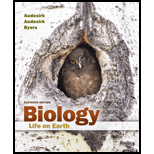
A cell that remains capable of dividing throughout the life of an organism, and that produces daughter cells that can mature into any of several different cell types is a
a. cancerous cell.
b. differentiated cell.
c. stem cell.
d. gamete.
Introduction:
The cells that have the capability to divide and get differentiated into different cell types are called the stem cells. The stem cells are of different types, the pluripotent stem cells, multipotent stem cells, and the totipotent stem cells. The multipotent stem cells are capable to give rise to different types of cells. The pluripotent cell types are capable to develop a part of the organ and the totipotent stem cells are those which have the capability to give rise to entire organism.
Answer to Problem 1MC
Correct answer:
The stem cells have the capability to divide throughout an organism’s life and get differentiated into several different types of the cells.
Explanation of Solution
Explanation/justification for the correct answer:
The stem cells like, hematopoietic stem cells are capable of dividing throughout the organism’s life. The hematopoietic stem cells, for example, are the source of all types of blood cells in the human body. The red blood cells and white blood cells are derived from the hematopoietic stem cells. The life of red blood cell is 120 days, after which has to be renewed; thus, the stem cells divide and get matured into the red blood cell types. Similarly, there are other types of stem cells that are capable of replacing the older cells.
Explanation for incorrect answer:
The cancerous cells divide uncontrollably and produce an extra mass of the cells that require continuous nutrients from the body. They do not replace the damaged cells. The differentiated cells are those that have already acquired a specific function. A gamete is a haploid cell and does not get divided further.
Thus, it can be concluded that the stem cells are the types of cells that divide throughout the organism’s life and produce different types of the cells. The cancerous cells produce only single types of the cells, the differentiated cells do not get divided further and the gametes only provide signals to zygote to divide further.
Want to see more full solutions like this?
Chapter 9 Solutions
Biology: Life on Earth (11th Edition)
- How is a protein destined for the Endoplasmic Reticulum (ER), imported into the ER? Be concise.arrow_forwardFind out about the organisations and the movements aimed at the conservation of our natural resources. Eg Chipko movement and Greenpeace. Make a project report on such an organisation.arrow_forwardWhat are biofertilizers and mention the significancearrow_forward
- PCBs and River Otters: Otters in Washington State’s Green-Duwamish River have high levels of polychlorinated biphenyls (PCBs) in their livers. PCBs can bind to the estrogen receptors in animals and disrupt the endocrine system of these otters. The PCBs seem to increase the estrogen to androgen ratio, skewing the ratio toward too much estrogen. How would increased estrogen affect the river otter population? Based on your reading of the materials in this unit, what factors can affect fertility in humans? Explain how each of the factors affecting human fertility that you described can disrupt the human endocrine system to affect reproduction.arrow_forwardOther than oil and alcohol, are there other liquids you could compare to water (that are liquid at room temperature)? How is water unique compared to these other liquids? What follow-up experiment would you like to do, and how would you relate it to your life?arrow_forwardSelection of Traits What adaptations do scavengers have for locating and feeding on prey? What adaptations do predators have for capturing and consuming prey?arrow_forward
- Competition Between Species What natural processes limit populations from growing too large? What are some resources organisms can compete over in their natural habitat?arrow_forwardSpecies Interactions Explain how predators, prey and scavengers interact. Explain whether predators and scavengers are necessary or beneficial for an ecosystem.arrow_forwardmagine that you are conducting research on fruit type and seed dispersal. You submitted a paper to a peer-reviewed journal that addresses the factors that impact fruit type and seed dispersal mechanisms in plants of Central America. The editor of the journal communicates that your paper may be published if you make ‘minor revisions’ to the document. Describe two characteristics that you would expect in seeds that are dispersed by the wind. Contrast this with what you would expect for seeds that are gathered, buried or eaten by animals, and explain why they are different. (Editor’s note: Providing this information in your discussion will help readers to consider the significance of the research).arrow_forward
 Concepts of BiologyBiologyISBN:9781938168116Author:Samantha Fowler, Rebecca Roush, James WisePublisher:OpenStax College
Concepts of BiologyBiologyISBN:9781938168116Author:Samantha Fowler, Rebecca Roush, James WisePublisher:OpenStax College Biology (MindTap Course List)BiologyISBN:9781337392938Author:Eldra Solomon, Charles Martin, Diana W. Martin, Linda R. BergPublisher:Cengage Learning
Biology (MindTap Course List)BiologyISBN:9781337392938Author:Eldra Solomon, Charles Martin, Diana W. Martin, Linda R. BergPublisher:Cengage Learning Human Biology (MindTap Course List)BiologyISBN:9781305112100Author:Cecie Starr, Beverly McMillanPublisher:Cengage Learning
Human Biology (MindTap Course List)BiologyISBN:9781305112100Author:Cecie Starr, Beverly McMillanPublisher:Cengage Learning Human Heredity: Principles and Issues (MindTap Co...BiologyISBN:9781305251052Author:Michael CummingsPublisher:Cengage Learning
Human Heredity: Principles and Issues (MindTap Co...BiologyISBN:9781305251052Author:Michael CummingsPublisher:Cengage Learning Biology: The Dynamic Science (MindTap Course List)BiologyISBN:9781305389892Author:Peter J. Russell, Paul E. Hertz, Beverly McMillanPublisher:Cengage Learning
Biology: The Dynamic Science (MindTap Course List)BiologyISBN:9781305389892Author:Peter J. Russell, Paul E. Hertz, Beverly McMillanPublisher:Cengage Learning





